2002.08.10 12:31
Re: graffiti
Michael wrote:
I was astonished by the new wave of graffiti in Sweden and Germany. Everywhere, even in the countryside, on bridges, tunnels, sides of buildings facing the railroad tracks and highways. I see beginnings of its reappearance in the US as well.
Steve adds:
Michael's use of the word 'reappearance' immediately reminds me of how much graffiti there used to be in the US (for me specifically Philadelphia). Michael might also be right about a 'reappearance' now occurring, because when I see graffiti here now (like in semi-remote places as Michael describes) I think to myself, "Now that's something I haven't seem in a long time." Mind you, I still don't see it that often.
Although never as 'famous' as New York City graffiti, Philadelphia was full of graffiti in the late 1960s through the 1970s. What happened as reaction, however, is now something of an 'institution'--the 'anti-graffiti' mural projects. Apparently, there are now more urban murals in Philadelphia than anyplace else in the world. They can be found everywhere, especially within 'poorer' neighborhoods (which more or less accounts for at least half of Philadelphia proper these days, and, more specifically, where you can find many, many blank sides of buildings due to ever increasing gap-tooth housing stock). From the late 1980s and throughout the 1990s these mural projects have taken on a very grand scale in terms of size and in terms of exhibiting talent and design. Almost every mural here now is indeed public art.
My favorite mural still has to be the one on 5th Street a few blocks south of the Roosevelt Blvd. that was painted spontaneously by Lotus and Dan Past Bird from noon 11 September 2001 to about noon 12 September 2001.
2002.08.10 12:47
Re: church plans (was synagogues)
While what P. says about 'sacred' sites remaining 'sacred' no matter what the religion (my take on the phenomenon, actually) is true, it is nonetheless worth noting that concerning Christian churches in the city of Rome, for several centuries all Pagan (temple) sites were strictly avoided as sites of Christian churches. The first pagan temple of Rome to be converted to a church is the Pantheon, but that didn't occur until the very early 600s. The story goes that some catacombs were caving in and that gathered remains of the fallen catacombs were deposited at the Pantheon, hence the buildings present name of Holy Mary of the Martyrs. If you believe in the Last Judgment, the Pantheon will surely be a 'watershed'.
In a more current situation, what was Congregation Ahavath Israel is today Grace Temple Church, Inc. (Talk about having it all.)
2002.08.16 13:49
Re: 1000 Kunstler
Interesting how Denise Scott Brown mentions "A small church or synagogue, set within a row of town houses or surrounded by office buildings, holds its own with dignity" in her editorial/op-ed piece on development of Lower Manhattan in today's NYTimes.
| |
2002.09.30 15:51
moving architecture
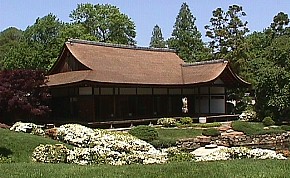
Yoshimura Junzoo, Shofu-so (Nagoya /Philadelphia: American Japan Society of Tokyo, 1953-57).
This 16th century style Shofu-so (Pine Breeze Villa) was constructed at Nagoya, Japan in 1953, then disassembled and shipped to New York City for exhibit within MoMA's sculpture garden in 1954, then disassembled again and shipped to Philadelphia's Fairmount Park.
The "Japanese House and Garden" now within Fairmount Park really is a moving architecture, not just literally moving, but even more so a 'spiritually moving' place. One can't help but feel transported when there. The garden is especially beautiful in early May when the many, many azalea bushes are in bloom.
When I first visited the house in 1975 it was one of those places (in Philadelphia) that was rarely visited. There was a young 'hippie-ish' tour guide 'working' there then, and he admitted to spending most of his time there completely alone. He said he loved it though, especially on rainy days because that's when he opened up the entire wall of the house that faced the lake/pond in the garden, and that's when he sat in the middle of the main room's floor "taking it all in."
2002.10.16 11:47
art and architecture 30 years ago
The following images feature highlights from Life magazine 1972.
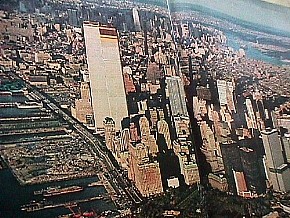 The World Trade Center towers nearing completion. Note how the Center was practically on the banks of the Hudson River then.
The World Trade Center towers nearing completion. Note how the Center was practically on the banks of the Hudson River then.
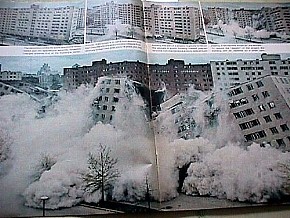 The implosion of Pruitt-Igoe Public Housing, St. Louis, Missouri. Minoru Yamasaki was the architect of Pruitt-Igoe Housing (1955-58) and architect of the World Trade Center towers (1972-73) as well.
The implosion of Pruitt-Igoe Public Housing, St. Louis, Missouri. Minoru Yamasaki was the architect of Pruitt-Igoe Housing (1955-58) and architect of the World Trade Center towers (1972-73) as well.
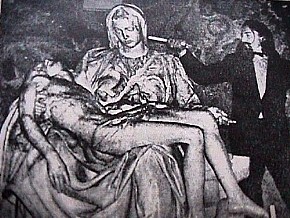 Laszlo Toth's attack of Michelangelo's Vatican Pieta.
Laszlo Toth's attack of Michelangelo's Vatican Pieta.
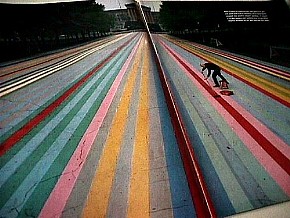 The world's largest painting--Franklin's Footpath--by Gene Davis on the parking lot in front of the Philadelphia Museum of Art--31464 square feet, 12 miles of masking tape used, 400 gallons of special paint. As predicted, it lasted about 5 years. (I fondly remember walking over it often. Oh boy, now I'm dreaming reenactment.)
The world's largest painting--Franklin's Footpath--by Gene Davis on the parking lot in front of the Philadelphia Museum of Art--31464 square feet, 12 miles of masking tape used, 400 gallons of special paint. As predicted, it lasted about 5 years. (I fondly remember walking over it often. Oh boy, now I'm dreaming reenactment.)
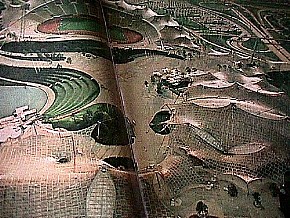 The 1972 Summer Olympic Complex, Munich, Germany. Architect-engineer Frei Otto's design still looks remarkably more refreshing than anything today's 'topology' architects imagine. (I fondly remember visiting this site late December 1975.)
The 1972 Summer Olympic Complex, Munich, Germany. Architect-engineer Frei Otto's design still looks remarkably more refreshing than anything today's 'topology' architects imagine. (I fondly remember visiting this site late December 1975.)
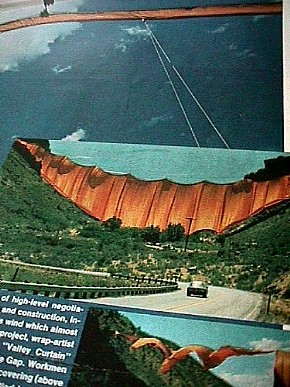
Christo's Valley Curtain at Colorado's Rifle Gap.
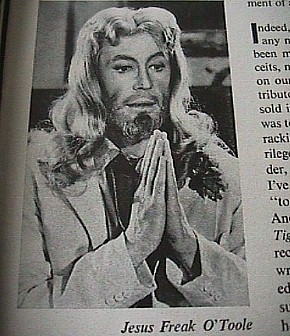
"Jesus Freak O'Toole" pictured with a review of the movie The Ruling Class. (Go rent this movie!)
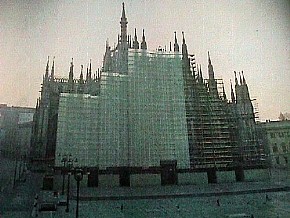 The scaffolded facade of Milan Cathedral. A sign of the future of pre-Modern architecture.
The scaffolded facade of Milan Cathedral. A sign of the future of pre-Modern architecture.
| |
2002.10.29 09:49
Re: Traffic Design
In describing what is now a somewhat ubiquitous housing type in the USA, Brian wrote, "not like townhouses with the 1st floor dedicated to parking, and housing above." My mother lives in such a model of early 1970s vintage, and most of Northeast Philadelphia is of like ilk. I too have seen this paradigm as more regrettable than not, yet at the same time I realize that my mother's house is oddly related to Le Corbusier's Villa Savoye, though without the pilotis, ramp and roof garden. The genealogy goes like this. First there is Savoye and Le Corbusier's housing project at Pessac. Savoye over the years decays but is rescued and restored as museum piece, all the while being an icon in print. Pessac is rather quickly transformed from Purist manifestation into what is essentially ur-postmodern design by its individual inhabitants. The house my mother lives in is then post ur-postmodern Pessac (but because it is part of a twin rather than part of a row, it still harbors buried evocations of Savoye).
The (row) house I live in, built in 1938, is (I believe just still) within the first generation of US housing to incorporate a garage. Here, all the designated parking happens in the back at ground level via a communal driveway, which in reality is a semi-private/semi-public street. From the back my house shows three stories, yet from the front the houses were made to look like two story dwellings via bermed lawns.
I sometimes wonder what Northeast Philadelphia would be like if its housing had more closely followed the design of Savoye and Purist Pessac. (Incidentally, Stonorov's and Kahn's Pennypack Woods housing, certainly among the first planned housing communities of Far Northeast Philadelphia, has a strong affinity with Pessac, kind of a combination of both Pessac's Purist and post-Purist manifestations.)
2002.11.21 14:04
what a difference 250 years make
Well, I did make a pilgrimage this morning down to Ridge Avenue and Buttonwood Street, Philadelphia, where "legend" has it that Benjamin Franklin flew a kite with key and discovered that lightening and electricity are the same thing 250 years ago. Although in an area still full of a lot of old warehouses, many now facilitating Chinese/Oriental businesses relative to Chinatown several blocks south, the "historic site" is an otherwise somewhat decrepit part of the city. There actually is an empty lot just east of Ridge Avenue on Buttonwood Street, and that's what I took pictures of. Otherwise, there is nothing at all to suggest that something of quite modern significance ever happen at this place, except perhaps the rather large outdoor electrical power station enclosed within a high chain-link fence a half block south on the other side of Ridge Avenue.
I had somewhat heightened expectations of my visitation since deciding to go yesterday morning. Last night I was watching a movie over a friends place, and I asked, "Do you know where Buttonwood Street is. I think it's right around Ridge and Spring Garden." My friend didn't have any idea, but offered me a SEPTA (Southeastern Pennsylvania Transportation Authority) map. I found Buttonwood Street a block south of Spring Garden Street, and I thought I actually knew the site because I thought it was where a building I finally photographed this past February was. This building/warehouse is one I've known since my college days, and I always admired it because of its facade's striking similarity with the facade of Venturi and Rauch's D'Agostino House (1968, unbuilt). I then found myself even wondering whether Venturi actually knew this warehouse because, just maybe, Venturi had once gone to make his own pilgrimage to Ridge and Buttonwood. Alas, the warehouse I know is not at Ridge and Buttonwood, rather at a similar intersection with Ridge Avenue a block north of Spring Garden Street. It should be noted that Ridge Avenue is one of Philadelphia's old zig-zagging diagonal streets in contrast to the otherwise planned grid of streets, off the grid because it follows an old "Indian" trail, and in Franklin's time was the main route out of town to the north-western countryside.
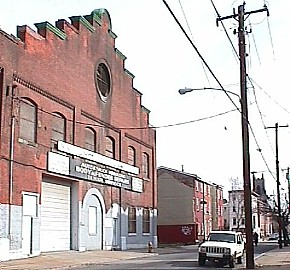 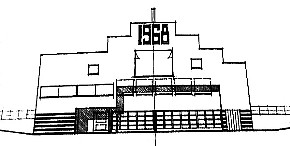
I now find myself wondering what all this "says" about us in the beginning of the 21st century, a people so reliant on electricity, yet otherwise largely oblivious to how we got that way. There is a tiny triangular block just south of the empty lot on Buttonwood Street with a small used-car business on it. I knocked on the office door, and a tall black Muslim (I assume by his garb) man in his thirties answered. I asked him if heard of the story of Benjamin Franklin flying a kite and "discovering" electricity. He said, "I don't think I ever heard dat." I told him Franklin did it here over 200 years ago. He said, "What? In dis building?" I said, "No. Like over there." Then he asked in a kind of mean voice, "Why you sayin' all dis?" I then smiled, but I didn't say much more.
As I drove home up Broad Street I thought to myself in irony, "Well that was a swell way to celebrate Quondam's 6th anniversary." And then I thought, if that's what Franklin's kite flying site is like after 250 years, God only knows what Quondam will be 244 years from now.
| |
2002.12.17 17:25
Re: a Bemused Tadao Ando observation
I have studied the evolution of Kahn's architecture beyond Kahn since my own architecture thesis 1981, and Ando's Museum of Literature design appears to be a late descendant of Kahn via late 1970s Stirling and early 1980s Isozaki.
Kahn's Levy Memorial Playground designs with Isamu Noguchi (1961-66, unbuilt), and his Dominican Motherhouse of Saint Catherine de Ricci (1965-69, unbuilt) engendered much formal architectural play, a genealogy that goes mostly unnoticed by architectural historians. Much of Predock's, work, for example, especially "reenacts" the Levy Memorial Playground designs.
Interesting how you relate the Museum of Literature to a kind of themepark. It could easily be said that Kahn's formal playfulness was inspired by Piranesi's Ichnographia Campi Martii, an ultimate plan of an ancient Roman themepark if there ever was one.
2003.01.01 13:24
site of first circumcisions
It seems that Mamre, the place of settlement and burial of Abraham, within today's Hebron, is also the site of the Abraham's and Ishmael's circumcision.
[1 January is the Christian feast of Christ's circumcision.]
At the east side of the Herodian enclosure are the foundations of the Basilica of the Terebinth of Mamre from the time of Constantine (4th-century AD), attributed to Constantine's mother-in-law, Eutropia. According to one source, when Eutropia visited the site, she found it defiled by idols and heathen sacrifices. When she informed Constantine of the situation the emperor wrote a letter (preserved in Eusebius' "Life of Constantine") to Macarius, the bishop of Jerusalem, and other bishops in Palestine, expressing his desire that the pagan altar be demolished and replaced by a church. This church was so important that it was depicted on the famous 6th century AD Madaba map. It was probably destroyed during the Persian invasion in 614 A.D.
--some results of a web search of eutropia hebron
2003.01.12 13:56
Re: the dead end of urbanism as we know it
John wrote:
Just about any large city today, is part farcical staged phony history [etc.]
Steve asks:
What parts or are there parts of any large city today that are un-farcical un-staged un-phony [history]?
I ask because I would like to see what might be the opposite of 'farcical staged phony history.'
[possible leads:] Is NYC's Central Park a farcical, staged and phony history, hence a tragi-comedy reenactment? I'd say kinda-sorta, but it's very much liked nonetheless.
Philadelphia's original grid plan is patently a reenactment of ancient Roman military/colonial urbanism. When I worked downtown in the 1980s I never tired of the street theater, which I surmised was engendered by the average street widths (just a tad too narrow for a modern metropolis), but I never saw the plan as farcical, staged, or phony. [Or did I just contradict myself? I'm again reminded that where there's real reenactment, there's usually inversion as well.]
Philadelphia's Fairmount Park is the largest urban park in the world, and it has a large collection of historic homes, indeed country estates from the 18th century when what is now Fairmount Park actually was 'out in the country' relative to Philadelphia. None of this is farcical, staged, or phony, rather true history. When you are at Mount Pleasant, for example, a true Georgian Manor, and you look at the adjacent ball-playing fields of today, what you are also looking at is a very old field where crops used to be grown.
Philadelphia's Independence Mall is today being newly reconstructed. Pretty much all the new stuff is (going to be) farcical, staged, and phony history, but none of it is reenactment.
|